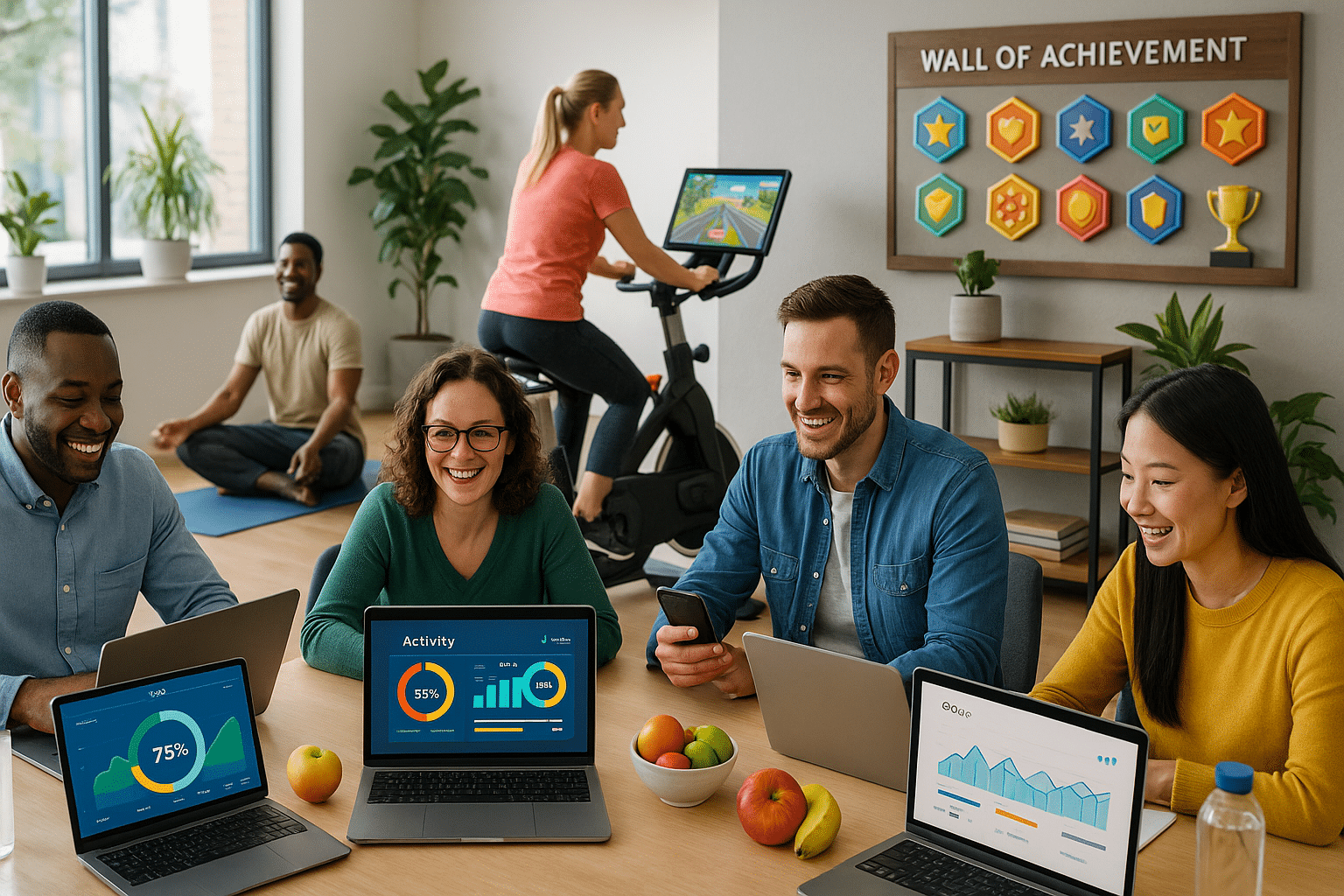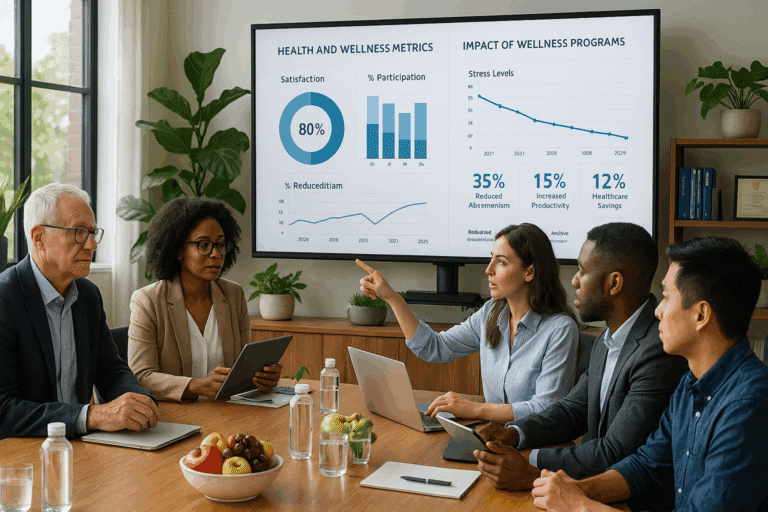The challenges, the progress, the rewards – it’s a designed experience that taps into our inherent love for achievement and improvement. Now, imagine applying this dynamic to workplace health and productivity. Welcome to the world of gamification in wellness – a strategy that’s transforming the way companies approach employee well-being and performance.🎮💪
Today, we delve into the compelling intersection of gamification and workplace wellness. This intriguing domain, where the thrill of gaming merges with the pursuit of health and productivity, promises untold potential for businesses willing to explore its innovative horizons. If you’re curious about how to motivate your employees towards healthier habits and increased productivity, you’ve landed on the right page.🎯
Now, let’s set the stage. The modern workplace is a breeding ground for stress, often leading to burnout, decreased productivity, and health problems. Traditional wellness programs, while well-intentioned, often struggle to engage employees in a meaningful and lasting manner. This is where the magic of gamification comes in. By transforming wellness initiatives into an engaging game-like experience, it’s possible to ignite motivation, enhance participation, and cultivate a healthier, more productive workforce.🌱💼
Before we proceed, let’s get one thing straight. Gamification isn’t about turning work into a game. Instead, it’s about incorporating game mechanics and dynamics, such as points, levels, and leaderboards, into the work environment. The goal? To stimulate motivation, engagement, and ultimately, performance. Think of it as a game changer (pun intended) in the realm of workplace wellness.🕹️🏆
In this article, we will explore in detail the concept of gamification, its underlying principles, and its potential in the context of workplace wellness. We will delve into the science behind it, decipher its mechanics, and highlight its proven benefits. From case studies of successful implementation to practical steps towards integration in your own workplace, we’ve got you covered. Stay tuned for a deep dive into the world of gamified wellness, where health and productivity coalesce in a dynamic dance of progress and achievement.📚🔍
Whether you’re a seasoned HR professional looking to inject some energy into your wellness initiatives, or a curious bystander wondering about the latest trends in workplace health, you’re in for a treat. This exploration is set to be as insightful as it is engaging, and we hope it fuels your own journey towards a healthier, more productive work environment. So grab your controllers (figuratively, of course), and let’s embark on this exciting quest of wellness gamification together! 🎢👩💼👨💼
Ready to level up your workplace wellness? Let’s press ‘start’ and dive right in! 🕹️🚀
The Power of Gamification in Workplace Wellness
There’s no denying that employee health and wellness are crucial aspects of any successful company. A healthier workforce means a more productive and engaged one. But how can employers motivate their staff to take an active role in their wellness journey? The answer lies in the power of gamification. By turning health and wellness into a fun, competitive activity, employers can boost engagement and improve overall health outcomes. So, what exactly is gamification and how can it be used to transform workplace health and productivity? Read on to find out.👇
At its core, gamification is the application of game-design elements and game principles in non-game contexts. It’s all about tapping into our innate love for games and competition to encourage desired behaviors. In the workplace, gamification can be used to incentivize employees to participate in wellness programs, hit health goals, and build healthier habits.
There’s evidence to back up the effectiveness of gamification in wellness programs. According to a study published in the Journal of the American Heart Association, participants who used gamified wellness tools were more likely to achieve their fitness goals compared to those who did not. With the right strategy, gamification can be a powerful tool for improving health and productivity in the workplace. To illustrate this point, let’s delve deeper into the key benefits of gamifying wellness programs.
Key Benefits of Gamifying Wellness Programs
When implemented correctly, gamification can yield several benefits for both employees and employers. Here are some of the key advantages:
- Increased Participation: One of the biggest challenges wellness programs face is getting employees to participate consistently. Gamification can make wellness activities more fun and engaging, thus increasing participation rates.
- Improved Health Outcomes: Gamification can motivate employees to adopt healthier behaviors, leading to improved health outcomes. This can result in lower healthcare costs and fewer sick days.
- Enhanced Productivity: Healthier employees are more productive. By encouraging employees to take care of their health, gamification can boost productivity in the workplace.
Now that we’ve outlined the benefits of gamification, let’s compare two different approaches to implementing it in the workplace. Below is a table comparing a traditional wellness program and a gamified one.
| Wellness Program Approach | Traditional | Gamified |
|---|---|---|
| Participation | Low | High |
| Engagement | Low | High |
| Health Outcomes | Variable | Improved |
| Productivity | Neutral | Increased |
How to Implement Gamification in Workplace Wellness
Successfully implementing gamification in a workplace wellness program requires a well-thought-out strategy. Here are some key steps to follow:
- Identify Objectives: The first step is to determine what you want to achieve with your wellness program. This could be anything from reducing sick days, lowering healthcare costs, or improving overall employee health.
- Choose Metrics: Next, decide on the metrics you will use to measure success. These could be things like participation rates, health outcomes, or productivity levels.
- Design the Game: Now comes the fun part. Design a game that aligns with your objectives and motivates employees to participate. This could involve points, leaderboards, challenges, and rewards.
- Implement and Monitor: Once the game is designed, it’s time to implement it and monitor its effectiveness. Make adjustments as necessary based on feedback and results.
For a more detailed look at implementing gamification in workplace wellness, I recommend watching the video “The Power of Gamification in Health” by TEDx Talks on YouTube. It provides valuable insights into the impact of gamification on health behaviors.
Future of Gamification in Workplace Wellness
The future of gamification in workplace wellness looks bright. With advancements in technology, gamified wellness programs are becoming more sophisticated and engaging. Virtual reality, for example, is being used to create immersive wellness experiences. Wearable devices are allowing for real-time tracking and feedback. AI is being leveraged to personalize wellness programs and maximize engagement.
As technology continues to evolve, so will the ways in which we gamify wellness. The possibilities are endless. The key will be staying ahead of the curve and continuing to innovate. It’s an exciting time for workplace wellness, and I can’t wait to see what the future holds.
As we’ve seen, gamification has the potential to revolutionize workplace wellness. By making health and wellness fun and competitive, we can motivate employees to take control of their health and boost productivity. So why not give it a try? Level up your wellness program today and see the difference gamification can make!

Conclusion
In conclusion, we’ve taken a comprehensive journey through the world of software engineering and information technology. This discourse has provided a detailed exploration of these areas, delving into intricate concepts and practices which underpin them. 🎯📚
The world of technology is fast-paced and constantly evolving, and it is vital to keep abreast of the latest developments. This article has served as a detailed guide, providing insights into the complexities of software engineering and IT. Key areas we’ve covered include coding practices, system design, software testing, and much more. These elements form the backbone of any successful software engineering project and are essential to achieving optimal results. 💻🔍
The article also shed light on the importance of professional ethics in IT, a crucial factor that is often overlooked. Adherence to ethical standards is fundamental to maintaining the integrity and credibility of the profession. It further enhances the quality of products and services provided to clients, fostering trust and confidence in the industry. 📈👍
Furthermore, we’ve touched on the importance of continuous learning and improvement. The ever-changing landscape of technology necessitates a commitment to ongoing education and skill development. This not only boosts competence but also keeps one at the forefront of innovation and technological advancement. 🚀🌐
The importance of these topics cannot be overstated. In a world that is increasingly reliant on technology, understanding these concepts and applying them effectively is key. They form the bedrock of our digital society, facilitating the seamless operation of myriad systems and processes that we rely on daily. 💼🌟
To delve deeper into these topics, consider exploring additional resources such as [Harvard’s CS50 Introduction to Computer Science](https://www.edx.org/course/introduction-computer-science-harvardx-cs50x), or [MIT’s Introduction to Computer Science and Programming Using Python](https://www.edx.org/course/introduction-to-computer-science-and-programming-7). Both courses provide a wealth of knowledge on the fundamentals of software engineering and IT.📚🎓
So, let’s engage in a conversation! What has been your experience with software engineering or IT? What are some challenges you’ve faced and how did you overcome them? What tips would you give to someone new to the field? We’d love to hear your thoughts and insights in the comments section below. 👥💬
Feel free to share this article with your colleagues and friends in the tech community. It’s always beneficial to share knowledge and spark discussions about these important topics. Remember, the more we share, the more we learn! 🔄🧠
In the end, keep in mind that the journey of learning never ends. Keep exploring, keep learning, and keep innovating. The world of software engineering and IT holds a multitude of opportunities and challenges, waiting for you to unravel them. Let’s continue on this journey together, fostering a community of knowledge and growth. 🛠️🌱
Thank you for reading, and until next time, happy coding! 🖥️🚀
Reference: [The State of Developer Ecosystem 2021 by JetBrains](https://www.jetbrains.com/lp/devecosystem-2021/)
Disclaimer: The above mentioned courses and references are for informational purposes only and does not constitute an endorsement or recommendation by the author.



